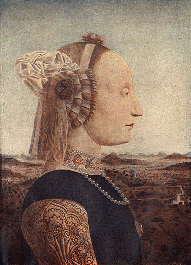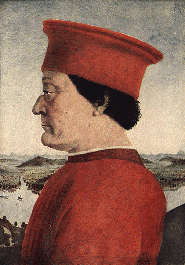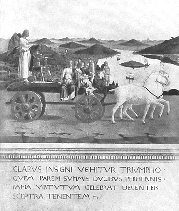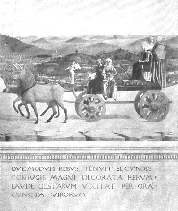Montefeltro Family
MONTEFELTRO FAMILY IN URBINO
Montefeltro Control over Urbino
The Montefeltro family gained control of Urbino in 1234 and ruled as lords. They held the rank of count until 1474, when Pope Sixtus IV conferred the rank of duke on Federico II da Montefeltro, the most outstanding member of the Montefeltro family.
Although Montefeltro descendants ruled during the rest of the Renaissance, the Montefeltro name died in 1508 with Federico's only son, Guidobaldo. He left no children and named his sister Giovanna's son as his heir.
Name Reference to Mountains
In beginning with monte, the Italian word for mountain, the name "Montefeltro" reflects the mountainous character of the terrain surrounding Urbino.
Employment as Condottieri
Because the region lacked income-producing resources, the Montefeltro counts worked as condottieri . Due to territorial disputes and the persistent desires of states to become larger and annex their neighbors, mercenary forces were much in demand in 15th-century Italy.
In addition to selling their military services, Montefeltro leaders served themselves in resisting pressures from land-grabbing neighbors and, on occasion, in enlarging Montefeltro territory.
Achievement of Success
It was not until the lifetime of Federico II da Montefeltro that the family achieved prestige and wealth on a par with the great courts of Ferrara and Mantua.
FEDERICO II DA MONTEFELTRO (ruled 1444-82)
Birth and Titles
Federico II da Montefeltro was the illegitimate son of Guidantonio da Montefeltro (ruled 1404-43). Guidantonio had Federico legitimized by Martin V (1517-31).
After the 1444 assassination of his half-brother, Oddantonio, who held that office for only a year, Federico became Urbino's Signore (governor) at the age of 22.
After being made a duke (dux in Latin) by Pope Sixtus IV in 1474, Federico broadcast his new status with inscriptions of "FE DUX," an abbreviation of Federico's Latin name and title, Federicus Urbini Dux.
Career as a Condottiere
Federico achieved great power through his exceptional skill as a condottiere. He fought as a mercenary, making short-term contractual agreements, rather than as an ally. Consequently, he fought in many wars and for the leaders of many states.
The inscription in the courtyard of Federico's palace at Urbino boasts that he never lost a war.
Federico tripled the size of Urbino's territory through his military prowess and his receipt of land from Pope Sixtus IV, one of his clients.
The disfigurement of his nose and the loss of his right eye occurred in a tournament in 1450. To minimize this disfigurement in portraits, the duke directed artists to portray him by profile views of his left side.
Marriage to Battista Sforza
Federico married Battista Sforza, a daughter of Alessandro Sforza, an illegitimate brother of Francesco Sforza, making her a cousin to Ludovico Maria Sforza.
After bearing six daughters and a son, Battista died in childbirth when she was 26.
Cultural Activities
Federico's education included a couple years at the Casa Giacosa in Mantua, a school run by the humanist Vittorino da Feltre under the sponsorship of Gianfrancesco I Gonzaga.
Federico's own court included many gifted scholars and was one of the most enlightened of the fifteenth century.
As an avid collector of manuscripts, Federico assembled one of the finest collections of the fifteenth century. He commissioned manuscripts and their illustrations as well. Among his collection were several architectural treatises: Vitruvius' De architectura libri decem, Alberti's De re aedicatoria, and Francesco di Giorgio's Trattati.
Patronage of Piero della Francesca
The most famous artist working for Federico was Piero della Francesca, a painter from Tuscany. While working in Urbino, Piero wrote a treatise on perspective that he dedicated to Federico. He painted a number of works for Federico over the years.
●Federico da Montefeltro and Battista Sforza. Piero della Francesca immortalized the duke and duchess of Urbino in a pair of profile portraits. She is dressed in finery, and he, as in other portraits, is dressed plainly. The relative darkness of the landscape behind Battista has been explained as a reference to her being dead when the portraits were painted. The portraits are mounted in a frame that reveals triumph scenes on their back sides. In these scenes, the duke and duchess sit in stately chairs on wagons being pulled by animals, his by stallions and hers by unicorns (symbols of chastity). Allegorical figures representing the virtues testify to their good character. The four cardinal virtues accompany Federico, and the three theological virtues accompany Battista.
●Flagellation of Christ. Piero's famous Flagellation of Christ was commissioned by Federico, but where it was to hang and whose features were represented by the foreground figures is uncertain.
●Ideal City. A painting of an Ideal City is believed to have been painted by Piero using architectural designs by Luciano Laurana, who was working for Federico at the same time.
Patronage of Justus of Ghent
Federico brought Justus of Ghent from Belgium to Urbino and commissioned him to paint several portraits as well as a number of works to decorate the studioli of his palaces at Urbino and Gubbio.
Decoration of Studiolo in Urbino
Federico's studiolo at the Palazzo Ducale in Urbino is the palace's most famous room. The lower walls are covered by intarsia decorations representing fictive cupboards filled with musical instruments, books, and other objects that might be found in a humanist's study. Mounted in two rows above the intarsia are 28 portraits of Famous Men, a series (1473-6) that Federico commissioned from Justus of Ghent.
Federico's Patronage of Architecture
By adding many churches and monasteries, Federico rebuilt much of the city of Urbino in the modern Renaissance style. His main architectural project was his palace in Urbino, which he turned into the city's most prominent feature.
♦Ducal Palace, Urbino, mid-1450s - mid-1480s. Over his lifetime, Federico greatly expanded the old palace of the Signoria, making the Palazzo Ducale the largest and one of the most sumptuous Italian palaces of the fifteenth century. The most innovative parts of the palace were designed and begun by Luciano Laurana. In the courtyard, he used right-angle piers at the corners and pilasters on the piano nobile above the ground-story columns. The staircase was large for its period and unusual in having a wide short first flight. The rooms of the main range are varied in shape and progress from large and public to small and personal. The two-wing façade was stylistically up-to-date in its use of smooth rustication, classically detailed trim, and rectangular, cross-mullioned windows. The positions of the rooms inside led to irregularities in the fenestration. Francesco di Giorgio linked the main range to the medieval Castellare (ruined castle) by a new wing on the east, a corridor-thick wall on the west side, and a garden terrace between them. A large stable and other service-related areas were located on the story below, which was above ground on the west side because of the sloping site.
♦Hunting Lodge, near Urbino. Federico built a hunting lodge outside Urbino called Barco Ducale. It was begun by Francesco di Giorgio and completed by Girolamo Genga between 1515 and 1535. It was later converted to a convent.
FEDERICO'S CHILDREN
Federico's Daughters
Five of Federico and Battista's six daughters were married to members of important families.
●Giovanna. Giovanna married Giovanni della Rovere, a nephew of Pope Sixtus IV and brother of Pope Julius II.
●Elisabetta. Elisabetta married Roberto Malatesta, the son of Sigismondo Pandolfo Malatesta (1417-68).
●Violante. Violante married Aoleotto Malatesta.
●Costanza. Costanza married Antonello Sanseverino, the Prince of Salerno.
●Agnesina. Agnesina married Fabrizio Colonna. The Colonna family in Rome, whose member Odo became Pope Martin V in 1417, played an important role in the politics of Rome and the Roman Catholic Church during the Renaissance. One of the two children of Agnesina and Fabrizio was Vittoria Colonna (1490-1547), a poet and friend of Michelangelo during his final Roman period (1534-64).
●Chiara. Chiara became a nun.
Federico's Son, Guidobaldo da Montefeltro
Battista died in 1472 giving birth to their only son, Guidobaldo.
After Federico's death in 1482, his son, Guidobaldo (ruled 1482-1508), succeeded him as the Duke of Urbino. Under Guidobaldo, who lacked his father's robust health and skill as a condottiere, the court of Urbino declined in magnificence and importance, and the size of the territory was never equaled again.
For a brief period (1502-03) at the end of the pontificate of Pope Alexander VI, Urbino was occupied by the pope's son Cesare Borgia, who commanded the Papal army and was amassing his own territory from papal land. After Pope Alexander's death in 1503, Urbino was restored to Guidobaldo.
Passing Title to della Rovere Family
Guidobaldo was married to Elisabetta Gonzaga, and they had no children. Consequently, he made the son of his sister Giovanna, Francesco Maria della Rovere, his heir. After 1508, the rulers of Urbino carried Montefeltro blood but not the Montefeltro name.
Battista Sforza and Federico da Montefeltro by Piero della Francesca, 1474 Rear sides: Triumph of Federico da Montefeltro and Triumph of Battista Sforza |



 Add Placemark
Add Placemark Go Back
Go Back 








